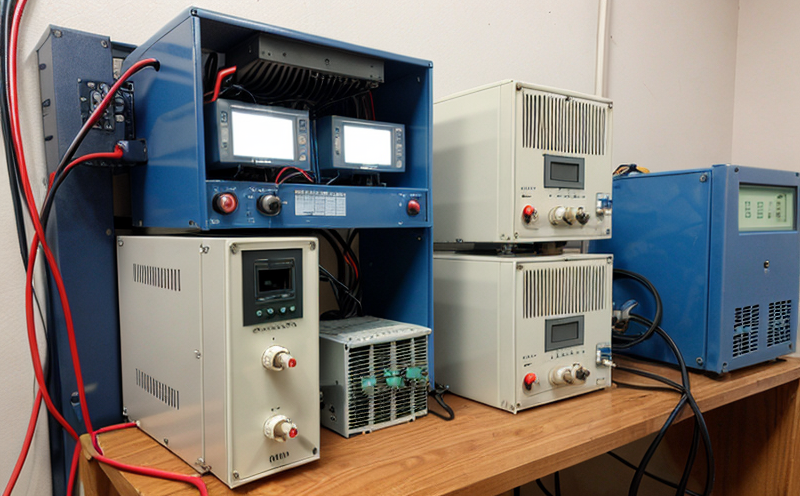UIC 607 Current Collection System Performance Testing
The UIC 607 test is a critical standard for evaluating the performance of current collection systems in railway vehicles. This testing procedure ensures that the electrical connections between the overhead power supply and the train are reliable, safe, and capable of delivering sufficient power to operate the vehicle efficiently.
Developed by the International Union of Railways (UIC), UIC 607 is widely recognized as a best practice for testing current collection systems. The test assesses several key parameters including contact pressure, wear rate, electrical resistance, and dynamic behavior under load. The primary goal is to ensure that these systems function reliably under real-world conditions.
The test setup involves simulating the actual operating environment of the train. This includes reproducing the physical motion and vibration typical of railway travel, as well as varying the current demand from the overhead line to simulate different operational scenarios. Specimen preparation for this testing is meticulous; it requires precise replication of the contact points between the pantograph and the overhead wires.
The instrumentation used in UIC 607 includes high-precision load cells, force sensors, and data acquisition systems capable of capturing detailed measurements. The test setup also includes a controlled environment chamber to simulate different environmental conditions such as temperature, humidity, and dust levels that could affect performance.
Acceptance criteria for the UIC 607 test are stringent, ensuring that all critical parameters meet specified limits. Compliance with these criteria is essential for ensuring safe and efficient operation of railway vehicles. The results of this testing play a crucial role in the design and certification processes for new trains as well as ongoing maintenance programs.
Understanding the nuances of UIC 607 testing helps quality managers, compliance officers, R&D engineers, and procurement teams make informed decisions about their current collection systems. It ensures that the systems are not only reliable but also optimized for performance under various operational conditions.
Scope and Methodology
The scope of UIC 607 testing encompasses a comprehensive evaluation of current collection system performance. This involves assessing the contact pressure between the pantograph and the overhead wire, measuring wear rates, evaluating electrical resistance under load conditions, and observing dynamic behavior during operation.
- Contact Pressure: Ensuring that the pantograph exerts optimal force on the overhead wire to maintain a stable current flow without causing excessive wear or damage.
- Wear Rate: Monitoring the rate at which contact points degrade over time, ensuring longevity and reliability of the system.
- Electrical Resistance: Measuring resistance levels under varying loads to ensure efficient power transfer and prevent overheating issues.
- Dynamic Behavior: Observing how the current collection system behaves during dynamic motion such as acceleration and deceleration, ensuring stability and performance.
The methodology involves a series of controlled tests designed to simulate real-world operating conditions. These include environmental simulations for temperature, humidity, and dust levels that can affect system performance. The use of advanced instrumentation ensures accurate and reliable data collection throughout the testing process.
Industry Applications
- Railway Vehicle Manufacturers: Ensuring compliance with international standards for current collection systems, enhancing product reliability and safety.
- Railway Operators: Conducting periodic testing to maintain system performance and identify potential issues before they lead to operational disruptions.
- Maintenance Teams: Using UIC 607 results to plan maintenance schedules effectively, optimizing resources and minimizing downtime.
- R&D Engineers: Designing new systems that meet or exceed the stringent requirements set by UIC 607, ensuring innovation in railway technology.
The application of these tests extends beyond just compliance; they are integral to maintaining a safe and efficient railway network. By adhering to UIC 607 testing protocols, stakeholders in the transportation sector can ensure that their systems meet the highest standards of performance and safety.
Why Choose This Test
The UIC 607 test is a cornerstone for ensuring the reliability and efficiency of current collection systems in railway vehicles. Its comprehensive approach to testing multiple critical parameters provides stakeholders with robust data on system performance under real-world conditions.
Compliance with this standard offers several advantages:
- Enhanced Reliability: Ensuring that the current collection system performs reliably, reducing the risk of breakdowns and operational disruptions.
- Safety Assurance: By verifying that all critical parameters meet specified limits, UIC 607 helps prevent accidents caused by unreliable systems.
- Innovation Support: The stringent testing criteria provide a benchmark for R&D teams to innovate and improve system designs.
- Cost Efficiency: Early identification of potential issues through periodic testing can reduce maintenance costs and avoid costly repairs.
For quality managers, compliance officers, R&D engineers, and procurement professionals involved in railway vehicle design and operation, the UIC 607 test is indispensable. It ensures that all systems meet the highest standards of performance and reliability, contributing to a safer and more efficient railway network.





